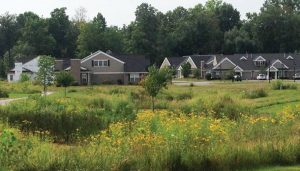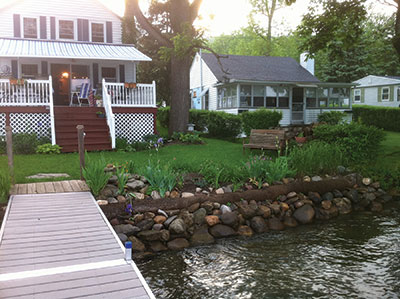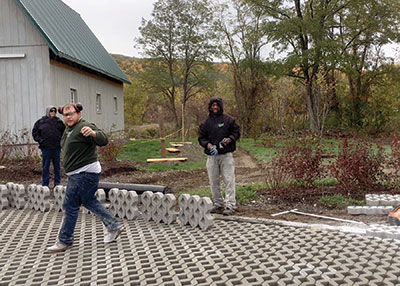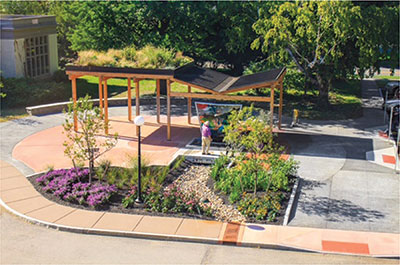Conservation by Design

photos courtesy Broccolo Tree and Lawn Care
Blog Post Reshared from:
https://www.lifeinthefingerlakes.com/conservation-by-design/
Conservation by Design
by Rachel Edwards
Our Finger Lakes Region is blessed with clean drinking water and an abundance of scenic fishing spots. But alarmingly harmful algal blooms (HABs) and extreme weather events remind us that our shorelines and drinking water are under threat. There is no one cause to “put your finger on” to fix it. Farms, non-functioning septic system, and excess lawn fertilizer are issues that need addressing. However, we can control the quality of groundwater flowing off our own roofs, landscape and surrounding property by adopting simple storm water methods; some ancient, some new. As communities search for techniques to manage storm water, it should come as no surprise that many of the best ideas to filter, recycle and replenish groundwater come from nature!
Every time it rains, water runs off roofs, driveways and roads. This potentially polluted water enters storm drains flowing directly into streams and ponds. According to EPA estimates, 70 percent of all water pollution results from storm-water runoff. More than 20 thousand gallons of water can pour off an average roof each year. Natural wetland filters have been replaced by agriculture and development. The erosion of farm fields and compacted lawns loose topsoil, nutrients, and manures when they are mowed too short or stripped of vegetation to serve as a filter buffer zone.

Coconut coir logs, a natural erosion control, are used to stabilize shorelines and slopes.
Native plants establish root systems to help retain the bank during storm surges.
With increasing regularity and intensity, storm water washes pollutants into our waters, contributing to harmful algae blooms. When storm water is absorbed into the ground, it’s filtered and ultimately recycled into aquifers, streams, and rivers. Fortunately, nature shows us ways to clean and recycle water allowing us to reduce our impact and contribute to sustainable solutions.
Good landscape design mimics nature – water is absorbed, filtered and allowed to recharge ground water. By using some commonsense techniques, landowners can prevent washing topsoil and pollutants directly into storm drains, streams and lakes. Rain gardens, swales, wildflower grassy meadows, and permeable pavers are techniques increasingly being used as “green infrastructure” to mimic nature’s own water handling. Here are a few examples easily adapted to home landscapes, which provide beautiful, productive habitats for native plants, birds, bees, and butterflies.
Rain gardens are simply native shrubs, perennials, and flowers planted in a small depression, designed to temporarily hold and gradually absorb rainwater. The existing soil within the garden is removed (or amended) and replaced with a more permeable soil typically consisting of a mix of sand, topsoil, and compost. Rain gardens are dry most of the time, retaining surface water runoff during storms, but designed to drain within 12 to 48 hours, so there’s little risk of breeding mosquitoes.
Compared to conventional lawn, rain gardens allow for 30-percent more water to soak into the ground. Rain gardens are effective in removing up to 90 percent of nutrients, chemicals, and most sediment from the rainwater runoff. Select native plants such as you might see growing along the edge of a wetland, such as bee balm, Joe-Pye weed, blue lobelia, blue flag iris, cardinal flower, goldenrods, and many ferns.

Permeable turf pavers are being installed at the
Finger Lakes Museum in Branchport. (fingerlakesmuseum.org).
Swales are essentially ditches designed to channel rainwater away from your home and property. Like rain gardens, they can filter runoff along the way, allowing it to soak into rapid-draining soil. Water tolerant plants absorb and slow down the flow of water. Heavy water flow may require a perforated pipe to be laid in gravel underneath the soil to handle the volume. Typically, a small swale may carry gutter water from a house to a dry well. Another swale might run along the contour of a hill to divert water around a low-lying house. Swales constructed with fast-draining soil, gravel and stones can be installed in deep shade or on slopes in those tough spots where plants and grasses have trouble growing.
Meadows are an effective way to reduce maintenance. Have the courage to stop mowing some areas like steep slopes, wet spots, and shady areas. They are great candidates for planting low-mow grass mixtures and wildflowers. Their roots stabilize the erosion of slopes and slow the flow of storm water. According to the U.S. Department of Energy, turf grass is the nation’s largest irrigated crop, covering more than 40 million acres. Mowers consume 1.2 billion gallons of gasoline annually. Native grasses like switch grass and little blue stem grow in tall clumps to create privacy with added benefits of less mowing and gas consumption. Wildflowers provide habitat for insects and other critters like bees, butterflies, and hummingbirds; providing nectar and host plants for the larval stage of certain butterflies.
Rochester Museum and Science’s Green Infrastructure showcase demonstrates a green roof, rain gardens, swales and permeable parking areas. www.rmsc.org/science-museum/exhibits/item/298-regional-green-infrastructure-showcase With every 1” rain storm, this green infrastructure design enables over 28,000 gallons of water to infiltrate and return to ground water.
Meadows should be designed as a functional plant community, sometimes requiring two to three seasons to get established with a good root system. Attractive one-size-fits-all wildflower seed packets somehow end up in a tangle of weeds and have disappointed many of us. By understanding your specific conditions, you can select plants that will thrive.
• Full sun is necessary for a meadow planting. Insufficient sunlight will favor woody invaders over wildflowers and grasses.

Rochester Museum and Science’s Green Infrastructure showcase demonstrates a green roof, rain gardens, swales and permeable parking areas. www.rmsc.org/science-museum/exhibits/item/298-regional-green-infrastructure-showcase With every 1” rain storm, this green infrastructure design enables over 28,000 gallons of water to infiltrate and return to ground water.
Meadows should be designed as a functional plant community, sometimes requiring two to three seasons to get established with a good root system. Attractive one-size-fits-all wildflower seed packets somehow end up in a tangle of weeds and have disappointed many of us. By understanding your specific conditions, you can select plants that will thrive.
• Full sun is necessary for a meadow planting. Insufficient sunlight will favor woody invaders over wildflowers and grasses.
• Identify and understand which soil type you are working with (sand, loam, clay) in order to select plants that will adapt successfully to the site. If poor soils exist, a decision can be made to either amend the soil or narrow the plant list to those that will tolerate that specific condition.
• Poorly drained or very dry soils can provide a competitive advantage to carefully chosen meadow species. Plants with strong ornamental characteristics such as butterfly weed and little bluestem grow well in dry sands, while turtlehead and New England aster will thrive and flower in poorly drained clay soils.
Green roofs have a proven track record for reducing water runoff and improving water and air quality. After the initial investment, owners benefit from beautiful green space, lower heating and cooling costs, reduced noise and air pollution, an extended life of roof membranes since they’re protected from weather extremes by vegetation.
Permeable paving materials are increasingly being used to allow surface water to be filtered and absorbed into the ground. This is especially useful around urban street trees. Options such as pervious concrete, porous asphalt, and pavers are now available for patios, driveways, and parking lots.
We have a vested interest in protecting our water quality to protect our own property values and drinking supply. All the swimming, recreation, sport fishing, winery trails and natural beauty are just what make life in the Finger Lakes so rewarding.
See for yourself!
Green Design in Action
• Finger Lakes Museum in Branchport. Turf paver parking, rain gardens.
fingerlakesmuseum.org
• Rochester Museum and Science’s Green Infrastructure Showcase, Rochester. Green roof, rain gardens, swales, permeable pavement
rmsc.org/science-museum/exhibits/item/298-regional-green-infrastructure-showcase
• I-Square Imaginarium, Irondequoit: Green roof, pervious concrete and sidewalks, rain gardens
i-square.us/going-green
Please contact Broccolo Tree and Lawn Care for more information on storm water management at broccolotreeandlawncare.com or call 585-424-4476.
Rachel Edwards is an ecological design consultant for Broccolo Tree & Lawn Care and co-founder of the Genesee Land Trust
